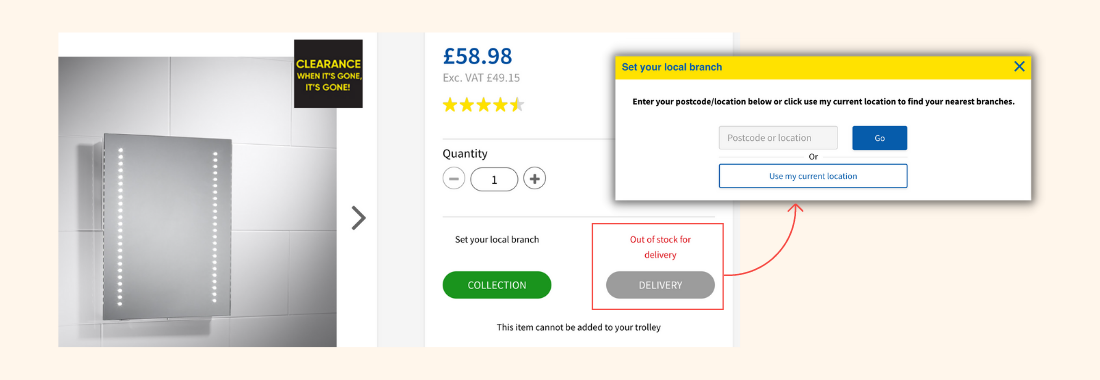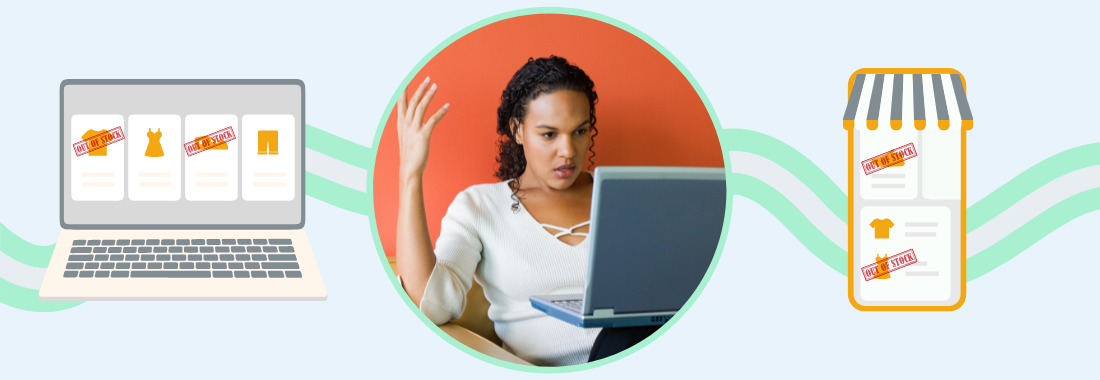So, you’re running out of stock quickly. It’s not a bad temporary place to be profit-wise, but when it comes to your business, out of stock can turn away ready-to-buy consumers who might never return! What it comes down to is an increase in friction from the shopping journey as a result of out of stock issues.
Below we discuss a few different ways to tackle stockouts. Whether it is adding quick onsite mechanisms or implementing new technology to achieve a seamless experience for online visitors – there are solutions that can help.
How Out of Stock is Affecting Your Online Sales And What You Can Do About It
An out of stock (OOS) on a website is one of a retailer’s biggest issues. The first most obvious reason is that a percentage of online revenue can be lost because of out of stock goods, especially when the customer is about to purchase. According to Harvard Business Review, retailers can lose nearly half of intended purchases when customers encounter stock-outs, with abandoned purchases accounting for about 4%.
But worse than that, out of stock (OOS) increases friction in the shopping journey which can lead to frustration, a poor shopping experience and ultimately, a loss of potential customers, as well as reduced customer loyalty and retention. Losing potential customers and existing customers means missed opportunities for engagement and potential damage to a retailer’s brand – something far more disappointing than a loss of initial sales. Yes, it goes beyond the revenue you would otherwise have made.
Harvard Business Review also shares, “When they can’t find the precise product they’re looking for, consumers typically do one of five things. They find a substitute of the same brand, they substitute a different brand, they delay their purchase until the item’s back in stock at that particular store, they don’t buy the item at all, or, worst for retailers, they buy the item at another store.” Forcing your prospective customers and their spend to competitors is a retailer’s nightmare.
Being an eCommerce store owner comes with a never-ending list of tasks and a lot of your out of stock issues might not be directly your fault. Perhaps your OOS issues are related to supply chain disruptions such as shipping delays or changes in trends causing increased demand for certain products. And if it’s not external factors contributing to out of stock, it could be related to poor forecasting or an inability to manage your product catalogue effectively due to time or resource constraints.
Not sure how to solve out of stock and avoid stockouts? Below are a few solutions to both external and internal out of stock issues.
1. Use tools to help forecast
One way to solve your out of stock management is to use a forecasting tool and a real-time inventory management system to improve your inventory management. These types of tools can also help you to see trends and check the demand for your most popular products. Taking a deep dive into your sales analytics can also show you data that can help better prepare you. When looking back over specific months, holiday periods or other predictable events, you can better determine the events to come.
Here are 10 of the best inventory forecasting tools in 2022.
2. Be transparent with your shoppers
One of the quickest ways to reduce friction from out of stock is clearly stating when and if the product will be available in the future.
Clear wording such as out of stock vs sold out can clarify whether a product will be restocked or is completely sold out. If something in your store is low in stock, you can also let your customers know by stating “we are running out of stock” or “only 1 left – be quick!”. This reduces frustration immensely, but is, of course, only a temporary solution to the out of stock issue.
But it’s not only what you share that will create transparency, it’s also what is not shared. If an item is out of stock and it is not likely to be added in stock again, then don't display it online. Although it may seem obvious, many retailers forget this and many online customers still become frustrated – no one wants their time wasted.
Example: Shopbox learns about your online visitor in real-time so that they only see items that are available in their size, reducing friction and guiding them further into your store.
3. Allow pre-orders and enable a ‘notify me' feature
In the case of supply chain disruptions, shipping delays or increased demand, allow your customers to pre-order the stock if it is currently unavailable. It is important to make sure to set the right expectations, clearly stating when the product will be shipped – something that can often be hard to do when external factors are involved.
Many retailers use the pre-order tactic before launching a new product line. This can allow retailers to preempt how much stock they will need, but also adds a layer of exclusivity for customers to order stock before it is even created, adding an extra layer of customer experience too.
Another useful tactic is to enable a ‘notify me’ feature in the case there is no stock of particular colours or sizes. If the customer really wants the product, they will add their email address to be notified when the item is available again. It’s an opportunity to not miss out on that sale, as well as possibly upsell to them in the future.

Source: Easons
4. Show alternative locations where the product is available
For eCommerce stores that work alongside physical stores, if the item is not available in your warehouse, you can direct the customer to other locations where they can collect the product. This will create a better shopping experience for the customer than a simple ‘out of stock’ message. Add a navigation feature too to allow them to check the store that’s nearest them or a ‘click & collect’ option.

Source: Toolstation
5. Enhance your online store and offer alternative products
If shoppers can’t buy the product they want, you should make it as easy as possible for them to find an alternative option, instead of leaving the store to go elsewhere. One way to do this is by displaying product recommendations that are particularly relevant to them.
Offer ‘close match’ alternatives in the size or colour they have expressed interest in to engage your shopper and reduce the chances of cart abandonment. Shopbox does just that, sharing curated recommendations to enhance the online customer experience. The Shopbox product recommendation engine helps to create a seamless shopping experience and one where the customer wants to stay on the page until checkout. By presenting infinite permutations based on their interests and behaviour, Shopbox provides a uniquely tailored shopping experience that leads to happier shoppers and higher-order values. Take a look at the below examples.

Source: Schuh
Provide the best customer experience possible
As part of enhancing your out of stock store, and solving the out of stock problem once and for all, be sure to utilise some of the smart moves mentioned above, all to create a better shopping experience for your customers.
Shopbox can radically improve your shoppers’ experience with an AI-powered adaptive shopping experience platform, and it can be up and running in no time. Simply get in touch with us today for a demo. If you enjoyed this article, we talk more retail, technology and customer experience in other articles on our blog.

